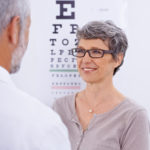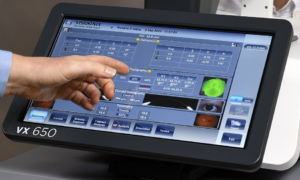By ROB Editors

Progressive lenses can be a great choice for many presbyopic patients, allowing seamless vision that allows the patient to forego taking their glasses off to read up close, or carrying a separate pair of reading glasses. The question is how to get patients to say yes. Here is what Shelley Smith, ABOC, CPOA, told us about how her practice achieved 82 percent multifocal sales in progressive lenses. ROB Editors also share tips for making patient purchases of progressive glasses more likely by offering patient financing via the CareCredit credit card.
Use a Doctor-Directed Process
“We use a doctor-directed process in which the doctor starts the conversation about new glasses by giving their recommendations to the patient. The doctors play an integral role in helping patients make their decision on the lens type that will work best for them,” Smith said. “As opticians, we rely on the doctor to lay the groundwork for the education we will provide the patient in the optical. We know that in our practice the doctor will have already pointed out to patients the benefits of progressive lenses, and why they are superior to bifocals, lined multifocals or relying on reading glasses.”
Help Patients Into a Great Pair of Progressives
Sponsored Content
Progressive glasses are not a new technology, but the design of these lenses is getting better and better. With so much potential to improve patients’ vision and comfort navigating the world, it’s a shame that some pass on progressive glasses because of the cost. If your practice offers patient financing via the CareCredit credit card, it is likely that many fewer patients will pass on this option.
Doctor: “Sandy, the progressive glasses I have prescribed have a very good track record with many other of my patients. It’s rare for a patient not to be able to adapt to these lenses, and I’m told they make life a lot easier.”
Patient: “I don’t know. I’m not sure it’s worth the money. They sound great, but it’s going to be a lot more expensive than my usual glasses. Maybe I could wait until next year and try them then.”
Doctor: You could definitely wait until next year to try them if you want, but you may not have to. We offer patient financing via the CareCredit credit card, which if you are approved, will allow you to space out payment. Many of my patients have found this to be a great way to be able to get the products I have prescribed for them without having to spend too much money all on the same day.”
The patient who is given options in how they pay for high-end products like progressive eyewear is a patient who may suddenly realize that there’s no time like the present to try that pair of progressive glasses. —ROB Editors
Part of the doctor-directed process is that the doctor begins the conversation on the type of lens the patient would be most successful with, Smith explained. “The doctor gives their recommendation to the patient in front of the optician and talks to the optician about anything special or unusual they uncovered during the exam. This could be anything from an unusual prescription or a special hobby the patient enjoys. The optician then takes over and digs deeper with the patient to determine the specific lens and treatments the patient needs. These conversations are imperative to the optician recommending the perfect solution to the patient,” she said.
Make Sure Opticians Fully Understand How Progressives Work
It’s hard to successfully fit and sell glasses you don’t understand, so training in how progressives work is essential. “For opticians to create successful experiences for progressive wearers they have to have a solid understanding of how the lenses work, how to take measurements properly, an understanding of how the patient is going to use the glasses and how to troubleshoot if a patient is dissatisfied with their new glasses,” said Smith.
Make Sure Our Younger Opticians Understand Presbyopia
Younger opticians, who have not experienced presbyopia themselves, can have trouble understanding the perspective of a person who needs a multifocal lens, said Smith. “Not understanding what a patient is seeing makes it difficult to understand how to troubleshoot problems, or even make the best lens recommendation based on how the patient uses their glasses,” she said. “The most effective training that we have for opticians struggling with progressive lenses is the training we get from our lab. Every time we send opticians to that training, they come back with a great understanding of how to work with the lenses and significantly more confident in talking to patients about progressive lenses.”
Manage Patient Expectations
The most important part of working with progressive wearers is to manage expectations from the beginning of the conversation, Smith noted. “It is imperative that progressive wearers understand how the lenses work and the limitations of the lenses. It is important that a patient who is choosing a lower-cost lens understands the tradeoffs that come with that lens. We have a great video resource we use to help explain this to patients. We also use comparisons to explain the differences in lenses related to cost,” she said.
Use Advanced Technology In Our Optical
Advanced technology also can make getting progressive right easier. “In two of our locations, we have Visioffice devices that we use to take measurements for patients purchasing progressives that require custom measurements. These devices are highly effective tools to get perfect measurements every time and give our patients a fun experience. This is also an amazing tool for us to get perfect measurements on tough-to-measure patients,” Smith said.
Track How Many Patients Purchase Progressive Glasses
Like any practice improvement initiative, tracking your progress quantitatively is important. “We track the percentage of progressives of total multifocal sales. It is important to us to make sure that we are talking to every potential multifocal wearer about progressive lenses and give them the opportunity to try them, even if they have historically worn a lined multifocal,” Smith said. “We want to make sure that every patient can experience the best possible products to enhance their vision.”



























